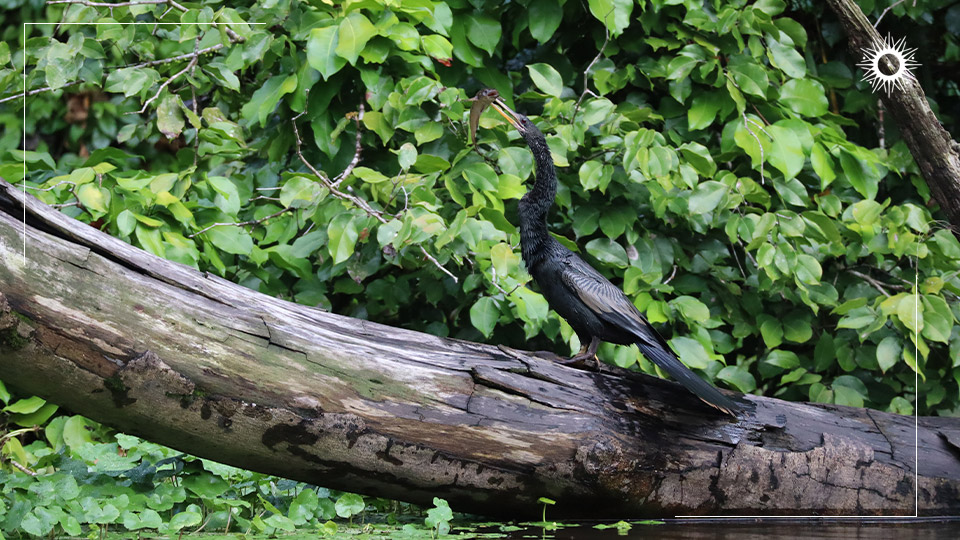BÖËNA ARTICLE
Tortuguero bird count tallies
a record 221 species

The bird counters were out in force, gliding along the muggy canals of Tortuguero in boats like ordinary tourists, but they were on a mission.
About 40 bird experts spent the day Jan. 29 tracking 12 areas to make a list of the 221 species they found in the Tortuguero region – a record high for this annual bird count.
Some 923 bird species are believed to exist in all of Costa Rica, and more than 400 live in the aquatic jungles of Tortuguero. The country’s Caribbean coast is notable in part for the great green macaw (Ara ambiguus), a beautiful parrot that is mostly green, with colorful splashes of blue and red. It’s considered critically endangered, existing only between Honduras and Ecuador.
Bird nerd Juan Molina, 38, a naturalist guide for Tortuga Lodge, participated in the count and said he saw some species that surprised him, but didn’t see others that had been spotted previously.

|

|
They saw all six species of kingfishers that lives here, including the rare belted kingfisher (a migrant from the U.S.), the green-and-rufous kingfisher and the American pygmy kingfisher. Known for feeding on fish, the kingfisher also eats snakes, crustaceans, frogs and other prey.
Bird counters also saw a sungrebe, a rare, ducklike bird that is often on birdwatcher’s wish lists. Molina calls it one of the “Top 10” you can see in Tortuguero. Male sungrebes have unique pouches under their wings that they use to carry hatchlings until they can survive on their own, which is why they are sometimes called “marsupial birds.”
It’s not often Molina spots a bird he’s never seen before, but he saw one on this trip: the pied puffbird. He was able to cross this fluffy little fellow, who eats insects and spiders, off his “lifer” list.
They also saw the great potoo, an owl-like carnivore that hunts by night. Molina said he saw one of these several times right at Tortuga Lodge.
As for the rare green macaw, Molina said he saw 32 of them flying in one group!
Molina said the bird spotters were dispatched to 12 locations in Tortuguero National Park and the Barra del Colorado Wildlife Refuge. A new methodology and an enlarged search area allowed experts to spot more birds than ever.

|

|
Some 25 local children were also involved, at least in the inaugural activities, though because of coronavirus restrictions they could not accompany the ornithologists on the actual count.
The complete list of species both spotted and not spotted reads like a “Who’s Who” of birds with funny names.
Spotted: Black-bellied whistling duck, gray-rumped swift, bronzy hermit, purple-crowned fairy, crowned woodnymph, purple gallinule, buff-throated saltator.
Not spotted: Slaty-breasted tinamou, gray-headed chacalaca, violaceous quail dove, chuck-will’s widow, American oyster catcher, greater yellowlegs, masked booby.
So why is it important to count birds?
“This bird count constitutes a notable scientific effort so that experts can determine a base for future studies about the many species,” said Gustavo Alvarado, minister of tourism, who was present at the bird count as an observer. “The ICT [Costa Rican Tourism Board] welcomes all national tourists to take advantage of the quality and variety of tourism services that Tortuguero offers, together with the scenic beauty in which you can do birdwatching and multiple other activities.”
According to ICT data, some 65% of international tourists participate in some kind of ecotourism, and 13% come to Costa Rica for birdwatching.

|

|
Tortuga Lodge, one of the top ecolodges in the region, provided transportation, boats and expert guides to assist in the count. Part of the Böëna Lodges collection, Tortuga Lodge believes in the “four C’s” of sustainability: conservation, commerce, community and culture.
Rodrigo Alfaro, manager of Tortuga Lodge, said this annual count is important “to generate consciousness among people, and above all to understand if we’re collaborating with the environment or harming it.” He said the most important thing humans can do is to keep bird populations healthy is not cut down trees – and plant more.
“Little by little more people are involved, and despite being a time of COVID, lots of people come to participate in the count,” said Molina. “I know professional birders from other countries, experts who have written books, who come here to see birds. So it’s not just learners, but experts who love to come here because they know they’ll see lots of birds.”
Alas, nobody spotted a white-crowned pigeon, which usually inhabits Caribbean islands, but tends to fly to the mainland to escape storms. The weather was perfect on the day of the count, which helped with spotting other species, yet this one apparently stayed away.
But there’s always next year.